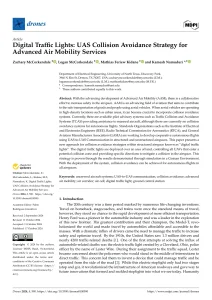- Directory
- Advanced Air Mobility White Papers
- Advanced Air Mobility (AAM)
- Digital Traffic Lights: UAS Collision Avoidance Strategy for Advanced Air Mobility Services
Digital Traffic Lights: UAS Collision Avoidance Strategy for Advanced Air Mobility Services
White Paper Details
This white paper introduces "digital traffic lights," a UAS-to-UAS communication system for collision avoidance in Advanced Air Mobility. The strategy enables autonomous flights by deploying ground-based control units that manage UAV movements through structured airspace zones, providing directional guidance similar to traditional traffic lights for safe aerial navigation.
This white paper presents an innovative collision avoidance strategy called "digital traffic lights" for Advanced Air Mobility (AAM) services. As AAM development accelerates, ensuring safe transportation of goods and people via aerial vehicles in high-density urban environments becomes critical. The paper addresses the limitations of current pilot advisory systems like Traffic Collision and Avoidance Systems (TCAS) for autonomous flight operations.
The digital traffic lights system deploys ground-based control units across land areas, creating potential collision zones that provide specific flight directions to UAVs entering the airspace. This infrastructure-based approach enables collision mitigation through UAS-to-UAS communication in structured and unstructured airspaces. The system architecture demonstrates how UAVs can navigate autonomously while avoiding collisions through simulation in a Cesium environment.
The white paper examines existing collision avoidance standards from organizations including IEEE, RTCA, and GAMA, highlighting the need for cooperative autonomous flight systems.
The authors detail the technical implementation, showing how digital traffic lights control UAV movements by assigning directional permissions similar to traditional road traffic management.
Key benefits include scalability for high-density urban operations, compatibility with existing AAM infrastructure, and the ability to handle multiple simultaneous autonomous flights. The simulation results validate the system's effectiveness in preventing collisions while maintaining efficient airspace utilization.
This white paper contributes significantly to AAM safety standards by proposing a practical, implementable solution that bridges the gap between current pilot-dependent systems and fully autonomous aerial operations. The digital traffic lights concept offers a pathway toward safer, more efficient urban air mobility, addressing one of the primary challenges facing the widespread adoption of autonomous aerial vehicles in populated areas.
